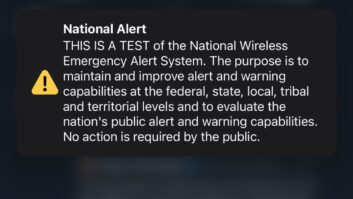Just as soon as the Rolling Stones jumped in to “Start Me Up,” the song stopped — and that was a good thing.
Wednesday’s nationwide test of the Emergency Alert System halted Mick from promising that he’d never stop, never stop — at least as heard on XM Satellite by one Radio World contributor at 11:20 a.m. Pacific time. Now, from across the country, comments continue to roll in to Radio World that the EAS IPAWS test widely went smoothly, as experienced in the field. (We reported a first batch yesterday.)
But we’re still watching for a consensus to emerge about how the subsequent filing process in the new FCC EAS Test Reporting System went. And official technical conclusions about the test and what it revealed await review and reporting by federal officials, who will, among other things, compare this experience with the first such national test in 2011.
The Federal Communications Commission did report Thursday that it had heard from more than 22,000 participants — broadcast stations and other EAS-involved entities — following the Sept. 28 test. And the test itself seems to have come through in most cases clearly and audibly.
Among the many comments that have reached Radio World from various sources:
The nine stations of the Nebraska Rural Radio Association received their test; “all ran perfectly with great audio,” said R.V. Zeigler, director of engineering for the Lexington-based group.
The same was reported by Jeff Smith, president of WRPQ(FM/AM/TV) in Baraboo, Wis., who said that the video and audio tests were received clearly and re-transmitted correctly through the stations’ Monroe Electronics DASDEC units.
There were no complications at WMUW(FM) in Columbus, Miss., where Eric Harlan, the GM and chief engineer, said the signal was received and transmitted. Similar thumbs up for the test came from stations in the Charm City of Baltimore, the sleepy burg of Neptune City, N.J., from Indianapolis and Seattle.
A veteran engineer in Pennsylvania had more luck with the test than with the FCC reporting system. He told RW the new ETRS form submission system “failed miserably. It had problems just like the Form 1 creation. The batch file uploading was not working at all from 2:20 p.m. up through 8 p.m., when I finally finished submitting all of the Form 2 information, individually station by station. Even that ran slowly at times. Some submissions had to be done two and three times before it was successful. Hopefully the batch file uploading system will be working before the deadline for Form 3!”
Several broadcasters expressed some surprise that the EAS test went so smoothly. “Much to my amazement, it worked well,” said Chuck Conrad, owner of KZQX(FM), KDOK(AM) and KEBE(AM) in Texas, who commented to an email query conducted by the group Christian Community Broadcasters.“The test went as scheduled and sounded very good.”
Conrad reported that his own subsequent filing via ETRS went off without a hitch, even though thousands of people were expected to log on to the site within a few hours of one another and the FCC had asked participants to stagger their filing of Form Two over the hours after the test. “Reporting only took a couple of minutes,” Conrad said. “I was expecting a logjam, but it didn’t happen.” Another broadcaster, in North Carolina, said Forms Two and Three were “easy and done.”
Larry Wilkins, the Alabama SECC chairman, said that out of 97 stations reporting to its FTP site, all 97 received and relayed correctly. “This seems to be the case from other areas around the state. There a few reports of problems that were related to configuration of local equipment. The FEMA origination and distribution worked perfectly with excellent audio quality. My congratulations to Al Kenyon head of IPAWS and his crew for putting this together.”
Wilkins added, “A number of the stations with our GSSNet satellite system actually received it faster than directly from IPAWS.This is due to the fact that IPAWS is a polling system with a 30 second turnaround and GSS is a push system with no delay.”
There were scattered test difficulties reported.
One low-power FM manager said his station wasn’t able to participate because his EAS unit went kaput two days before the test, possibly because of lightning damage. The unit is at the factory for repairs, he said.
Lighting may have struck twice: A station in Florida reported that it received only alert tones and not the audio. The engineer said that the station’s EAS equipment may have frozen thanks to a lighting storm.
One LPFM reported problems receiving the national test code, possibly due to a software update issue.
It has been reported that several television stations in Los Angeles did not broadcast video crawls of the test. Another person in Malibu said a box at an LPFM station “did not get an IPAWS alert.” It received off-air broadcast signals but experienced problems with AM audio quality, “signal way too dirty hear to be considered anything near good.”










